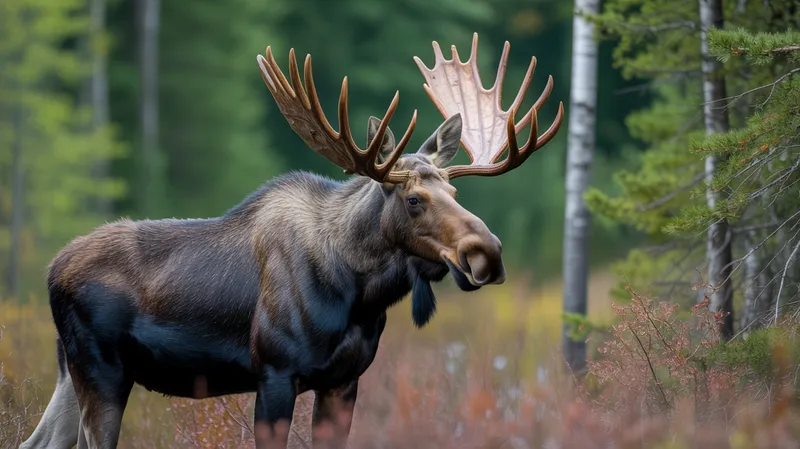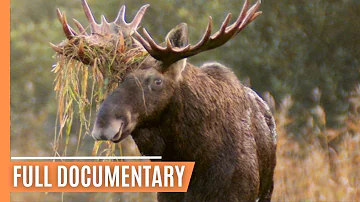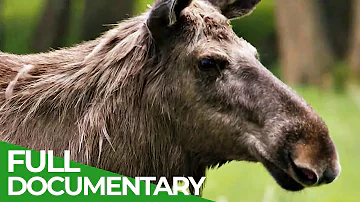
Moose
Alces alces

Meet the Moose
The moose is the largest member of the deer family, distinguished by its long legs, broad, palmate antlers in males, and a distinctive dewlap or 'bell' hanging from its throat. Found throughout northern North America, Europe, and Asia, moose thrive in boreal and mixed deciduous forests with abundant water sources. They are solitary animals, rarely forming groups except during mating season or a mother with her calf. Moose are excellent swimmers and can run surprisingly fast despite their size. Their unique adaptations enable them to survive harsh winters and browse on vegetation few other animals can reach.
Classification
Mammal
Habitat
Boreal forest and mixed deciduous forest near wetlands
Diet
Herbivore
Lifespan
15-25 years
Conservation
Least Concern
Weight
200–700 kg (440–1,540 lbs)
📖Fascinating Facts
Largest Deer
Moose are the largest members of the deer family, with adult males (bulls) standing up to 2.1 meters (6.9 feet) tall at the shoulder.
Expert Swimmers
Moose are strong swimmers, able to cross lakes and rivers and even submerge completely for up to 30 seconds to feed on underwater vegetation.
Selective Browsers
Their diet consists mainly of leaves, twigs, bark, and aquatic plants, allowing them to feed on vegetation that is often out of reach for other herbivores.
📋Detailed Description
The moose (Alces alces) is the largest extant member of the Cervidae family, with adult males (bulls) standing 1.4–2.1 meters (4.6–6.9 ft) at the shoulder and weighing between 380–700 kg (838–1,543 lbs), while females (cows) are smaller, averaging 200–490 kg (441–1,080 lbs). Moose are characterized by their long, overhanging muzzles, large prehensile upper lips, and a prominent dewlap or 'bell' hanging from the throat, whose function is still debated. Bulls possess massive, broad, palmate antlers that can span up to 2 meters (6.6 ft) across, which are shed and regrown annually. Their legs are long and powerful, enabling them to traverse deep snow and wade through wetlands, while their splayed hooves provide stability on soft substrates. Moose have a thick, insulating coat of hollow guard hairs and dense underfur, which, combined with a low surface-area-to-volume ratio, allows them to withstand extreme cold. Their large, mobile ears provide acute hearing, and their sense of smell is highly developed. Moose are primarily crepuscular, feeding at dawn and dusk, and are solitary except during the rut or when cows are raising calves. They are excellent swimmers, capable of crossing large lakes and rivers, and can dive up to 6 meters (20 ft) to forage for aquatic vegetation. Their digestive system is adapted for a high-fiber diet, with a four-chambered stomach that efficiently processes woody browse.
💡 Did you know?
Moose have a special adaptation in their nose that warms cold air before it reaches their lungs, helping them survive extremely cold environments.
🔬Research & Sources
Wikipedia Summary
The moose or elk is the world's tallest, largest and heaviest extant species of deer and the only species in the genus Alces. It is also the tallest, and the second-largest, land animal in North America, falling short only to the American bison in body mass. Most adult male moose have broad, palmate antlers; other members of the deer family have pointed antlers with a dendritic ("twig-like") configuration. Moose inhabit the circumpolar boreal forests or temperate broadleaf and mixed forests of the Northern Hemisphere, thriving in cooler, temperate areas as well as subarctic climates.
Last Modified: 6/10/2025
🎭Behavior & Social Structure
Moose are solitary and highly territorial, with individuals maintaining overlapping home ranges that can vary from 5 to over 100 square kilometers depending on habitat quality. They are browsers, feeding primarily on leaves, twigs, bark, and buds of woody plants such as willows, birches, and aspens, as well as aquatic plants like pondweed and water lilies in summer. Feeding bouts are interspersed with periods of rumination and rest. Bulls are generally more active and cover greater distances during the autumn rut, while cows are more sedentary, especially when rearing calves. Aggression peaks during the breeding season, with bulls engaging in antler displays, vocalizations, and occasionally violent clashes to establish dominance. Outside the rut, moose avoid conspecifics, reducing competition for food. Predators include wolves, bears, and, in some regions, Siberian tigers; calves are especially vulnerable. Moose are known for their unpredictable temperament and may charge when threatened, especially cows with calves.
👶Reproduction & Life Cycle
The breeding season, or rut, occurs from late September to early October. Bulls compete for access to estrous cows through vocalizations (low grunts and bellows), scent marking, and antler sparring. After mating, gestation lasts approximately 230 days (about 8 months), with most calves born in late May or early June. Cows typically give birth to a single calf, though twins occur in areas of high nutritional quality. Newborn calves weigh 8–15 kg (18–33 lbs) and are able to stand and follow their mother within hours. Maternal care is intensive, with cows fiercely defending calves against predators. Calves are weaned at 5–6 months but may remain with the mother until the following spring, when the next breeding cycle begins. Sexual maturity is reached at 2–3 years, though bulls may not successfully breed until older due to competition.
🛡️Adaptations & Survival
Moose exhibit several adaptations for survival in cold, forested environments. Their large body size and thick, insulating fur minimize heat loss, while their long legs allow efficient movement through deep snow and marshy terrain. The prehensile upper lip and flexible tongue facilitate selective browsing on high branches and aquatic plants. Moose can close their nostrils while submerged, enabling them to feed underwater. Their digestive system is specialized for processing high-fiber, low-nutrient browse, with a large rumen and symbiotic microbes. Seasonal antler growth in bulls is energetically costly but provides a visual signal of fitness during the rut. Behavioral adaptations include seasonal migrations in some populations, shifting between winter and summer ranges to optimize food availability and avoid deep snow.
📚Research Sources
🎨Cultural Significance
Moose hold significant cultural importance across their range. For Indigenous peoples of North America and northern Eurasia, moose have been a vital source of food, clothing, and tools for millennia, and feature prominently in folklore and spiritual traditions. In Scandinavian and Russian mythology, the moose is often associated with wilderness and strength. Moose imagery is common in heraldry, art, and national symbolism, particularly in Canada, Sweden, Finland, and Russia. The animal is a popular subject in ecotourism and wildlife observation, and its antlers and hides have traditional and contemporary uses.
🔬Recent Research & Discoveries
Recent research has focused on the impacts of climate change and parasite dynamics on moose health, with studies documenting population crashes in parts of the United States due to winter tick infestations exacerbated by milder winters. Advances in GPS tracking have revealed complex seasonal migration patterns and habitat use, informing conservation planning. Genetic studies have clarified the relationships among moose subspecies and their historical biogeography, while ongoing research investigates the physiological mechanisms underlying their cold tolerance and dietary specialization. Studies on moose-vehicle collisions have led to the development of wildlife crossings and mitigation strategies.
🎥Wildlife Videos

Nature's Haven - Moose Life in Matsalu National Park | Full Documentary
Matsalu National Park at the Baltic Sea is known for being one of Europe's most important stopover places for migrating birds.
Free High-Quality Documentaries

Super Moose (Full Episode) | America the Wild
#FullEpisode #AmericaTheWild #NatGeoWILD About Nat Geo Wild: National Geographic Wild is a place for all things animals ...
Nat Geo Animals

Moose - Giants of Sweden's Forests | Free Documentary Nature
Moose - Giants of Sweden's Forests | Wildlife Documentary Watch 'Norway: Land of Fjords, Islands and Vikings' here: ...
Free Documentary - Nature

HARSH ALASKA | The Survival Struggle of Wildlife | Animal documentary
Welcome to "HARSH ALASKA | The Survival Struggle of Wildlife," an awe-inspiring documentary that transports you to the rugged ...
WILD NATURE - Nature animal documentary

Moose in the Wild: Nature's Northern Giants Revealed - 4K WILDLIFE DOCUMENTARY 2024
Journey into the wild and uncover the fascinating biology of the moose, North America's largest deer. From their towering antlers ...
WILD WONDERS

Canada's Most Dangerous Animal... The Moose? | Natural Kingdom | Real Wild
In Canada, more people are killed or injured in vehicular collisions with moose than by all other wildlife species combined.
Real Wild
🌍Habitat Information
The Moose typically inhabits Boreal forest and mixed deciduous forest near wetlands environments. Mooses have adapted to their environments with specialized features and behaviors.
Primary Habitat:
Boreal forest and mixed deciduous forest near wetlands
More detailed habitat information will be available soon.
🛡️Conservation Status
The Moose is currently classified as Least Concern. Conservation efforts are crucial for preserving this species for future generations.
Common Threats:
- 🏠Habitat loss and fragmentation
- 🌡️Climate change impacts
- 🎯Hunting and poaching
- 🏭Human-wildlife conflict
⚠️Threats & Conservation Challenges
While the global moose population is stable and classified as Least Concern, regional populations face significant threats. Habitat fragmentation from logging, road construction, and urban development reduces available range and increases vehicle collisions, a leading cause of mortality in some areas. Climate change poses a growing threat by facilitating the northward expansion of parasites such as winter ticks (Dermacentor albipictus) and brainworm (Parelaphostrongylus tenuis), which can cause severe morbidity and mortality. Warmer winters also reduce snow cover, increasing predation risk and altering food availability. In parts of Europe and Asia, overhunting and poaching have led to local declines. Conservation challenges include managing human-wildlife conflict, maintaining genetic diversity, and monitoring disease outbreaks.
🔬Scientific Classification
Scientific Name
Alces alces
Classification Hierarchy
🔍 About Taxonomic Classification
Taxonomic classification is a hierarchical system used by scientists to classify and organize living organisms based on shared characteristics and evolutionary relationships.
The system moves from broad categories (Kingdom) to increasingly specific ones, with each animal's scientific name typically consisting of its Genus and species.
📝Community Notes
Share your observations and insights about the Moose with our community of wildlife enthusiasts.
Join Our Community
Sign in to share your observations and connect with fellow wildlife enthusiasts.
Sign In to ContributeNo community notes yet
Be the first to share your observations about the Moose!
Explore Moose
Select a tab above to learn more about this amazing animal.
📸Photo Gallery
No photos available for this animal yet.
🌟Discover More Wildlife
Continue your journey of discovery with more fascinating animals from our database
